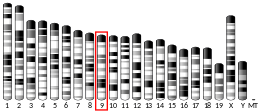VPRBP
Protein VPRBP is a protein that in humans is encoded by the VPRBP gene.[5][6][7]
Interactions
VPRBP has been shown to interact with Merlin.[8]
gollark: I can dredge up some usable alternatives, I suppose.
gollark: Why not?
gollark: Actually Additions, Applied Energistics 2, Ender IO, Thermal Expansion/Foundation/Innovation, Redstone Arsenal, CC: Tweaked, FoamFix (performance-improving mod), Compact Machines, Psi, Botania, Wireless Crafting Terminal, Tinkers' Construct, NuclearCraft, Plethora Peripherals, Quark, JEI (obviously), The One Probe (useful utility mod), Xaero's Minimap, Computronics, OpenComputers, Akashic Tome, Better Builders' Wands, ME Capability Adapter, RFTools.
gollark: I'm working on it.
gollark: Hold on while I dredge up my modlist.
References
- GRCh38: Ensembl release 89: ENSG00000145041 - Ensembl, May 2017
- GRCm38: Ensembl release 89: ENSMUSG00000040325 - Ensembl, May 2017
- "Human PubMed Reference:". National Center for Biotechnology Information, U.S. National Library of Medicine.
- "Mouse PubMed Reference:". National Center for Biotechnology Information, U.S. National Library of Medicine.
- Zhao LJ, Mukherjee S, Narayan O (June 1994). "Biochemical mechanism of HIV-I Vpr function. Specific interaction with a cellular protein". The Journal of Biological Chemistry. 269 (22): 15577–82. PMID 8195203.
- Zhang S, Feng Y, Narayan O, Zhao LJ (January 2001). "Cytoplasmic retention of HIV-1 regulatory protein Vpr by protein-protein interaction with a novel human cytoplasmic protein VprBP". Gene. 263 (1–2): 131–40. doi:10.1016/S0378-1119(00)00583-7. PMID 11223251.
- "Entrez Gene: VPRBP Vpr (HIV-1) binding protein".
- Huang J, Chen J (July 2008). "VprBP targets Merlin to the Roc1-Cul4A-DDB1 E3 ligase complex for degradation". Oncogene. 27 (29): 4056–64. doi:10.1038/onc.2008.44. PMID 18332868.
Further reading
- Tan L, Ehrlich E, Yu XF (October 2007). "DDB1 and Cul4A are required for human immunodeficiency virus type 1 Vpr-induced G2 arrest". Journal of Virology. 81 (19): 10822–30. doi:10.1128/JVI.01380-07. PMC 2045451. PMID 17626091.
- Wen X, Duus KM, Friedrich TD, de Noronha CM (September 2007). "The HIV1 protein Vpr acts to promote G2 cell cycle arrest by engaging a DDB1 and Cullin4A-containing ubiquitin ligase complex using VprBP/DCAF1 as an adaptor". The Journal of Biological Chemistry. 282 (37): 27046–57. doi:10.1074/jbc.M703955200. PMID 17620334.
- Hrecka K, Gierszewska M, Srivastava S, Kozaczkiewicz L, Swanson SK, Florens L, Washburn MP, Skowronski J (July 2007). "Lentiviral Vpr usurps Cul4-DDB1[VprBP] E3 ubiquitin ligase to modulate cell cycle". Proceedings of the National Academy of Sciences of the United States of America. 104 (28): 11778–83. Bibcode:2007PNAS..10411778H. doi:10.1073/pnas.0702102104. PMC 1906728. PMID 17609381.
- Le Rouzic E, Belaïdouni N, Estrabaud E, Morel M, Rain JC, Transy C, Margottin-Goguet F (January 2007). "HIV1 Vpr arrests the cell cycle by recruiting DCAF1/VprBP, a receptor of the Cul4-DDB1 ubiquitin ligase". Cell Cycle. 6 (2): 182–8. doi:10.4161/cc.6.2.3732. PMID 17314515.
- Borgne-Sanchez A, Dupont S, Langonné A, Baux L, Lecoeur H, Chauvier D, Lassalle M, Déas O, Brière JJ, Brabant M, Roux P, Péchoux C, Briand JP, Hoebeke J, Deniaud A, Brenner C, Rustin P, Edelman L, Rebouillat D, Jacotot E (March 2007). "Targeted Vpr-derived peptides reach mitochondria to induce apoptosis of alphaVbeta3-expressing endothelial cells". Cell Death and Differentiation. 14 (3): 422–35. doi:10.1038/sj.cdd.4402018. PMID 16888644.
- Zhao LJ, Zhang S, Chinnadurai G (2002). "Sox9 transactivation and testicular expression of a novel human gene, KIAA0800". Journal of Cellular Biochemistry. 86 (2): 277–89. doi:10.1002/jcb.10214. PMID 12111997.
- Nagase T, Ishikawa K, Suyama M, Kikuno R, Miyajima N, Tanaka A, Kotani H, Nomura N, Ohara O (October 1998). "Prediction of the coding sequences of unidentified human genes. XI. The complete sequences of 100 new cDNA clones from brain which code for large proteins in vitro". DNA Research. 5 (5): 277–86. doi:10.1093/dnares/5.5.277. PMID 9872452.
This article is issued from Wikipedia. The text is licensed under Creative Commons - Attribution - Sharealike. Additional terms may apply for the media files.



